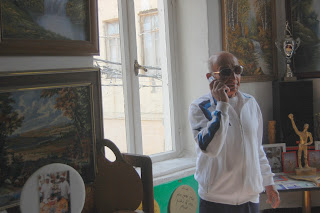
To escape the news and stretch a leg, we decided to take a Shabbat morning walk to sadnaot ha-omanim - the Artists Studios gallery on the border between Florentin and Yaffo. On show is an exhibition by a friend, the talented photographer Roi Kuper. The photos here are not from his show (I wish) but from the short walk to the gallery and back.

The exhibition is called White Cliffs of Dover (see at
http://roikuper.com/) and to accompany the lustrous images he created, Roi had laid on a recording of the Vera Lynn version of the wartime hit (
There'll be bluebirds over...). It felt strange to be listening to this classic piece of British nostalgia in Tel
Aviv. Roi claims there was second verse of the song, less schmaltzy and more realistic than the first that was edited out of all versions. And, by the way, there are no bluebirds in England.
According to first reports, despite the harsh criticism of the much-anticipated Winnograd report, Olmert does not intend to resign and will try to tough it out and hope the storm will pass. But the political wheels are spinning. Tsipi Livni is forming coalitions in and out of her Kadima party to prepare for a possible leadership grab while Olmert is getting into bed with Agudat Yisrael just in case Labour quits and he needs to prop up his coalition.

These wooden houses are in the American Colony, on the seam between Florentin and Yaffo, a failed attempt by American members of the Messiah's Church to set up shop in the Holy Land. They were later bought by the German Templers. The area includes Emanuel Church and a Christian hostel. As the wave of building and gentrification moves southwards this previously neglected area has suddenly become attractive and a chunk of it has been bought up for conservation and development.These modest houses will no doubt be worth a fortune in a year or two.
They've survived the Turks, the British and , with any luck, will even survive the ravages of the wholesale development that is sweeping through this part of town.

Until that happens there are still a few magical spots to be discovered among the huts and shacks, garages and workshops. This shot
carefully avoids the
refuse on both sides
of the frame. It reminds me of an idealised painting by Nahum
Gutman of an Arab house surrounded by palms with a spring from which women are drawing water. Such places were swallowed up as Jewish Tel
Aviv developed and were almost completely destroyed after the 1948 war. This site too will be gone too before long.







Comments